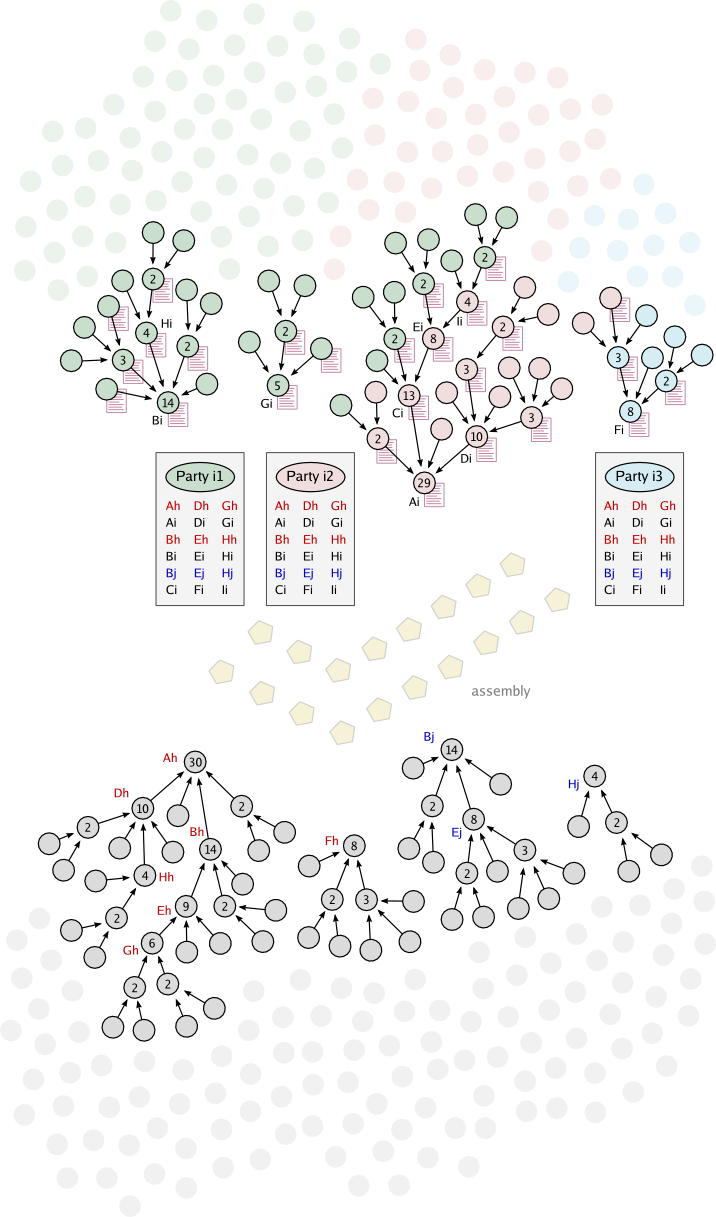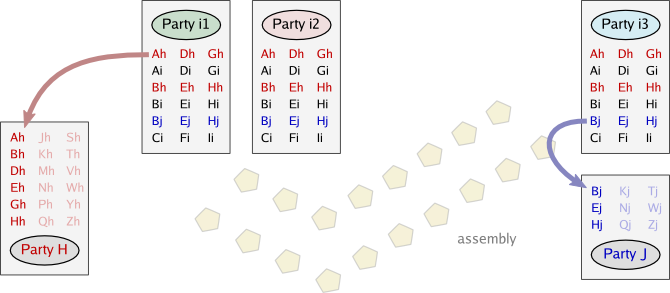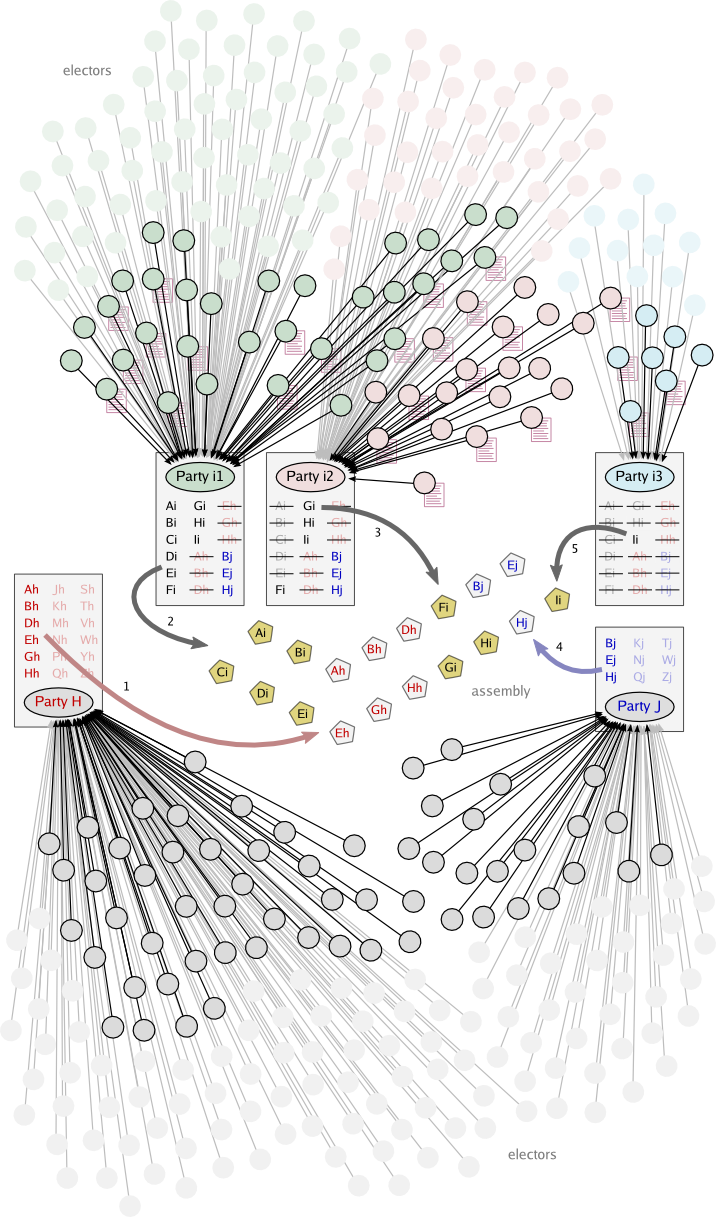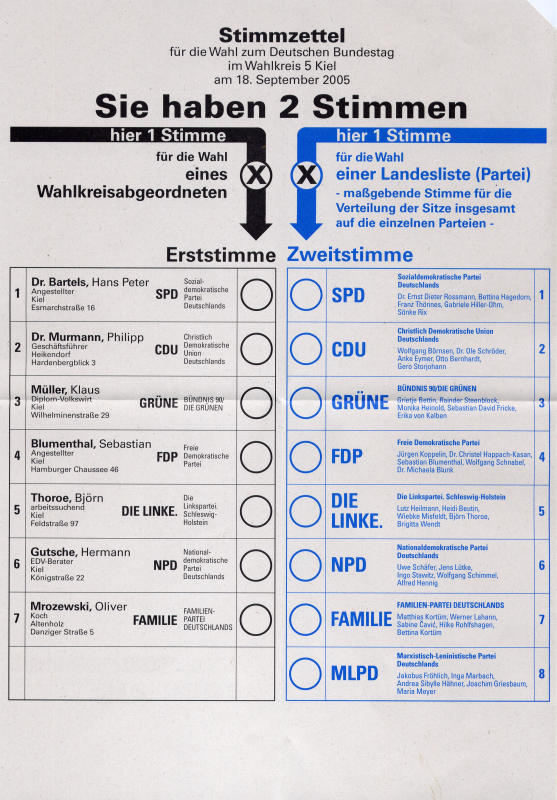Stuff:Votorola/p/mA:Guidance of multi-winner assembly elections
Standard practice
The standard practice begins with a continuous, non-stop primary for the purpose of nominating candidates for the assembly. The primary is open to both independent and party nominees. It is open to all primary toolsets that are able to share voting data via a mirroring inter-network. The continuous results are therefore expected to provide the most accurate available prediction of the membership of the next assembly. They take the form a list of nominees ranked in order of popularity, with the leading nominees being the predicted membership of the next assembly. The entire predicted membership is taken as the primary candidate list (unfinalized) for a network of formal parties known as "open parties".2 This nomination practice is shown in figure N.
 |
The open parties are formally political parties, but actually just primary toolsets or toolset hosts. They have no political identity, neither individually or collectively. All open parties share more-or-less the same candidate list,7 which is just the expected membership of the assembly as predicted by each toolset. The predictions are more-or-less identical because they are based on mirrored votes. In a parliamentary system, the open parties also share the same formal party leader, who is just the leading root of the open executive primary. The same leader might be shared with a traditional closed party, as well. The open parties cannot be politically opposed to any of the closed parties. Nevertheless they are technically opposed to the party system as a whole. They are expected to undermine that system and to replace it with an inter-network of primary toolsets. Already the open primary enabled by those toolsets is predicting the membership of the next assembly with an unrivalled accuracy (figure N above). Now the closed parties must nominate their own candidate lists, but their choices are largely restricted to these same candidates who are predicted to win seats.
 |
The open parties too must finalize their candidate list before the election. This they extract from the primary results, yielding all candidates from all parties who are predicted to be elected to the new assembly.8 The order of candidates, however, is changed in this final list. Those candidates who are already placed on closed party lists, or likely to be placed, are moved to the end of the list. There they are grouped by party, larger parties first. The effect of this reordering is that the supporters of closed parties may now shift their votes to an open party with the assurance that the results will be unchanged. This effect can be seen in the election of figure E, below. Closed party H is to elect 6a candidates (Ah. Bh, Dh, Eh, Gh, Hh), while the open parties among them are to elect 9a candidates (Ai to Ii). If a sufficient number of H voters decide to switch their support to open parties on election day, then the last of H's candidates (Hh) will not be seated by H. Instead Hh will remain on the open party list (not crossed off) and eventually be seated as the final candidate by open party i3.9 The vote shift by H's supporters therefore has no effect on the election. The implication is that party H itself has no effect; it might as well not exist. The same is true for all the other closed parties. They no longer appear to serve any purpose. Their candidates, members, voters and other supporters are therefore apt to be "siphoned off" by the open parties. Carried far enough, this could eliminate the entire party system. After all, the open parties are not parties at all; they are just primary toolsets dressed up to look like parties.
 |
The assurance that votes on election day may shift from closed to open parties without unseating anyone depends on the distribution of seats among the open parties and closed parties. For a closed party H, the number of seats that may shift from its smaller closed rivals to the open parties that are larger than H is limited. It must not exceed the combined size of the open parties that are smaller than H. Otherwise H will unseat candidates from its smaller rivals.
H i1 i2 J i3
---- ---- ---- ---- ----
Ah x Ai x Ai Ai
Bh x Bi x Bi Bj x Bi
Ci x Ci Ci
Dh x Di x Di Di
Eh x Ei x Ei Ej x Ei
Fi Fi x Fi
Gh x Gi Gi x Gi
Hh x Hi Hi x Hj x Hi
Ii Ii Ii x
Ah Ah Ah
Bh Bh Bh
Dh Dh Dh
Eh Eh Eh
Gh Gh Gh
Hh Hh Hh
Bj Bj Bj
Ej Ej Ej
Hj Hj Hj |
i1 H i2 i3 J ---- ---- ---- ---- ---- Ai x Ah x Ai Ai Bi x Bh x Bi Bi Bj - Ci x Ci Ci Di x Dh x Di Di Ei x Eh x Ei Ei Ej - Fi + Fi Fi Gi + Gh x Gi Gi Hi + Hh x Hi Hi Hj - Ii Ii x Ii Ah Ah Ah Bh Bh Bh Dh Dh Dh Eh Eh Eh Gh Gh Gh Hh Hh Hh Bj Bj x Bj Ej Ej x Ej Hj Hj Hj x |
Figure S summarizes a worst case scenario of open vote shifting for election E. Here all of party J's votes have shifted to open party i1, which is now larger than party H. In general, a shift like this across a larger party is potentially unsafe. But the results are unaffected in this particular case, because J's candidates are seated by the smaller open parties i2 and i3.9 Owing to the presence of this buffer of smaller open parties, even the most extreme of vote shifts is safe in this election.
i1 H J i2 i3 K ---- ---- ---- ---- ---- ---- Ai x Ah x Ai Ai Bi x Bh x Bj x Bi Bi Ci x Ci Ci Di x Dh x Di Di Ei x Eh x Ej x Ei Ei Ek x Fi x Fi Fi Gi Gh x Gi x Gi Hi Hj x Hi x Hi Ii Ii Ii x Ah Ah Ah Bh Bh Bh Dh Dh Dh Eh Eh Eh Gh Gh Gh Hh Hh Hh Bj Bj Bj Ej Ej Ej Hj Hj Hj Ek Ek Ek |
i1 H i2 i3 J K ---- ---- ---- ---- ---- ---- Ai x Ah Ai Ai Bi x Bh x Bi Bi Bj - Ci x Ci Ci Di x Dh x Di Di Ei x Eh x Ei Ei Ej - Ek - Fi x Fi Fi Gi + Gh x Gi Gi Hi + x Hi Hi Hj - Ii + Ii Ii x Ah + Ah Ah Bh Bh Bh Dh Dh Dh Eh Eh Eh Gh Gh Gh Hh Hh Hh Bj Bj x Bj Ej Ej x Ej Hj Hj Hj x Ek Ek Ek |
Figure U summarizes a worst case scenario for a different election, one in which unsafe open vote shifts are possible. Here the buffer of smaller open parties (i2 + i3) is insufficient (3 seats) to absorb the vote shift (4 seats) that stretches across closed party H and into the larger open party i1. Consequently Ek is not seated by the open parties as predicted in the primary. That would require that the distribution of open parties be better balanced, or the size of the vote shift reduced.
In Germany
The German parliament (the Bundestag) is elected by the additional member system with closed party lists.10 A fixed number of seats (S) are reserved for the direct election of district members (Wahlkreisabgeordneten), one for each of the S electoral districts (currently 299). Additional members are then seated from party lists (Landesliste), thus maintaining overall proportionality. This brings the regular size of the assembly to 2S or 598 seats. This number may be lower owing to the election of independent or non-party district members, or higher owing to overhang seats.11 The elector has two votes on the ballot: one for a district candidate (left in figure FEB) and one for a party list (right).
 |
If the SPD candidate in figure FEB (Dr. Bartels) wins the seat for Kiel district, then overall party proportionality is maintained by seating one less candidate from the SPD list than would otherwise be seated. But if the seat were instead won by an independent candidate (if any were on the ballot), then the total number of seats would be reduced by 1.13 It is therefore possible to reduce the Bundestag to just S seats (299) by electing independent candidates alone. This unprecedented result would eliminate the parties from politics, save the expense of several hundred seats, and simplify the overall electoral process. The open primaries might then be implemented purely as single-winner primaries, one per district. But if this is a good end to work toward, it is not a practical means of achieving that end. The present situation works greatly to the disadvantage of independent candidates. They cannot make use of dual candidacy.14 They are confronted by powerful parties and strong party candidates who receive top placement on the ballot. So severe are these disadvantages that no independent has been elected to the Bundestag since 1949.15
The ideal practice would therefore be a combination of single-winner primaries for the district seats and multi-winner primaries for the additional list seats, both linked by dual candidacy through the open parties. German election law, however, does not allow multiple party nomination as required by the standard multi-winner practice.16 The standard practice must therefore be modified at the election stage (figure E). The largest open party (most used primary toolset) of each state (Land) becomes the open party for that state. It submits a single list of all candidates who consent to being nominated. Likewise it nominates the leaders of the state's district primaries, the nomination for each going to the highest vote receiver who consents to it. Nominations are offered regardless of political affiliation. This is the crucial point. The open party wants to attract the best candidates of the closed parties. The law forces candidates to segregate on party lines in the final list, but has no effect in the open primary; all candidates (party and independent) are there co-joined and the electoral strength of each is revealed in relation to the others. All but the weakest closed-party candidates will have the option of being elected by accepting the closed-party nomination as usual, or by accepting the open-party nomination instead. The consequences of enabling this option are explored in figure NB.
In scenario (2), candidate Eh accepts the open-party nomination instead of her usual H nomination. She is replaced by Gh (H list), and displaces Fi (i1 list). This has the strange effect of helping the left, while simultaneously hurting the left party (H). It helps the left because 5 left candidates (Ah, Bh, Dh, Gh from the H list, plus Eh from the i1 list) are now predicted to be elected, but it hurts the left party because its primary electoral strength drops as a consequence from 63 to 60n;3 it now has weaker candidates. Worse still, a former candidate has demonstrated her electoral independence and called into question the purpose of the party. If party H is no longer the means of getting elected on the left, then what purpose does it serve? What is to prevent other candidates from following in the footsteps of Eh and accepting open party nominations?
(0)
all
---
30 Ah
29 Ai
14 Bh
14 Bi
14 Bj
13 Ci
10 Dh
10 Di
9 Eh
8 Ei
8 Ej
8 Fi
---
6 Gh
5 Gi
4 Hh
4 Hi
4 Hj
4 Li
---
|
(1)
H i1 J
--- --- ---
Ah
Ai
Bh
Bi
Bj
Ci
Dh
Di
Eh
Ei
Ej
Fi
--- --- ---
--- --- ---
63 + 82 + 22
= 167 |
(2)
H i1 J
--- --- ---
Ah
Ai
Bh
Bi
Bj
Ci
Dh
Di
- Eh
Ei
Ej
-
--- --- ---
Gh
--- --- ---
60 + 83 + 22
= 165 |
(3)
H i1 J
--- --- ---
Ah
Ai
- Bh
Bi
Bj -
Ci
- Dh
-
Eh
-
Ej
-
--- --- ---
Gh
Hh
Hj
--- --- ---
49 + 94 + 12
= 155 |
Scenario (3) therefore explores a more extreme shift of nominations. By displacing non-aligned candidates on the i1 list, the left increases its predicted seat count by 50% (from 4 to 6). Not to be outdone, the right also increases its seat count by 50% (from 2 to 3). That is the most they can do. Perhaps it is also the least they can do, as neither is likely to tolerate the other gaining an advantage in seats. But the resulting shift in electoral strength is also extreme. The closed parties (H and J) lose 24n primary votes between them, while the open party gains 12n; the open party takes the cream of the candidates and leaves the closed parties looking hollowed out. This puts some strain on the primary prediction as it concerns the balance among parties. At least some of the primary voters currently supporting candidates Bh, Bj and Dh are likely to follow suit on election day, shifting their votes to the open party. The extremes of this candidate-oriented vote shift are explored in figure FC.
(0)
all
---
30 Ah
29 Ai
14 Bh
14 Bi
14 Bj
13 Ci
10 Dh
10 Di
9 Eh
8 Ei
8 Ej
8 Fi
---
6 Gh
5 Gi
4 Hh
4 Hi
4 Hj
4 Li
---
|
(1)
H i1 J
--- --- ---
Ah
Ai
Bh
Bi
Bj
Ci
Dh
Di
Eh
Ei
Ej
Fi
--- --- ---
--- --- ---
63 + 82 + 22
= 167 |
(3)
H i1 J
--- --- ---
Ah
Ai
- Bh
Bi
Bj -
Ci
- Dh
-
Eh
-
Ej
-
--- --- ---
Gh
Hh
Hj
--- --- ---
49 + 94 + 12
= 155 |
(4)
H i1 J
--- --- ---
Ah
Ai
- Bh
Bi
Bj -
Ci
- Dh
Di
Eh
Ei
Ej
Fi
--- --- ---
--- ---- --
39 + 120 + 8
= 167 |
If all electors follow the candidates as shown in scenario (4), then the extra seats on the left and right that were sought in (3) are erased. Instead the candidates predicted in the primary (0) are elected. The nomination shifters (Bh, Bj, Dh) benefit from safer placement on the i1 list, with Di, Ei, Fi being elected to the tail. They also benefit by escaping the collapse of the party system. Nothing remains to prevent Ah, Eh and Ej from following them and making the collapse total. A more likely outcome, however, is something in between scenarios (3) and (4). At least some electors continue to vote on party lines, if only from habit. and it will probably take multiple election cycles to break with tradition and effect a total collapse of the party system. The open parties and multi-winner primaries would then be shelved, as they would no longer serve any purpose. The districts would elect all independent candidates. The Bundestag would then automatically be reduced to 299 seats; 299 for the districts, and zero for the parties.13 The hearts of the parties are instead transplanted to the executive primaries (left and right), whence the strongest is invited to lead the open party (i1) into the election.
Addenda
See also
- Stuff:Votorola/p/guidance of assembly elections - in general
Property settings
- Issue type (Category:Assembly)
- Place (Stuff:Decision guideway) 18
- Place (Stuff:System gap) 19
- Purpose (Stuff:Votorola/p)
Notes
- ^ See Stuff:Broad-based decision guidance.
- ^ Open parties are also known as "technical parties", or "public parties".
- ^ a b c Where n is some large number.
- ^ Toolset differences among the voters of closed party candidates are currently not shown in the figures. It's yet unclear how toolset usage might vary between open and closed voters.
- ^ Experienced drafters among the voters of closed party candidates are currently not distinguished in the figures. It's yet unclear how drafting experience might vary between open and closed voters.
- ^ a b Where 'a' is some number.
- ^ A nomination shared by multiple parties is variously termed "multiple party nomination", "fusion", or "cross endorsement". http://en.wikipedia.org/wiki/Electoral_fusion
- ^ Care should be taken in extracting official snapshots or decisions from a continuous primary. See the discussion here for a possible solution based on random selection: http://lists.electorama.com/pipermail/election-methods-electorama.com/2013-March/031647.html
- ^ a b To simplify the analysis, the seating of candidates is described as though it proceeded one party at a time, with the candidates of the more popular party seated first. More likely the seating will actually alternate among the parties, with the more popular being seated only at a higher rate; not all at once. Presumeably this will not affect the conclusions in regard to the neutrality of open vote shifts, but this has yet to be demonstrated.
- ^ http://www.wahlrecht.de/english/bundestag.htm, http://en.wikipedia.org/wiki/Electoral_system_of_Germany#Classification_and_assessment_of_the_system
- ^ The 2009 Bundestag was elected with 24 overhang seats, bringing the total membership to 622. Retirement of overhang members (who are not replaced) had reduced the total to 620 by 2013.
- ^ a b Federal Election Act (Bundeswahlgesetz). Last revised 1996, Federal Gazette I p. 1712. http://www.iuscomp.org/gla/statutes/BWG.htm
- ^ a b BWahlG9612 6 (1).
- ^ Dual candidacy is allowed in German elections. The SPD district candidate in figure FEB (Dr. Bartels) might also appear on the SPD Landesliste. This would give him the possibility of winning either direct election, or election by list.
- ^ http://en.wikipedia.org/wiki/West_German_federal_election,_1949
- ^ "A candidate may only be nominated in one Land, and there only in one Land list. Only such persons as have given their consent in writing may be named in a Land list; such consent shall be irrevocable." BWahlG9612 27 (4).
- ^ The primary prediction ignores any possible effects from the 12 district elections for Berlin. It is valid only if there is no dual candidacy between district and list elections, and if the districts elect proportionally among the three parties (4 candidates to H, 6 to i1 and 2 to J). Otherwise the election cutoffs below the 12th primary candidate (---) might be higher (dual candidacy), and/or vary from party to party (proportionality adjustment). But such effects are unlikely to favour one party over another, and unlikely therefore to invalidate the conclusions.
- ^ The guiding consensus is formed within the open primary as described here.
- ^ Guidance from the open primary enters the electoral system across the system gap as described here. A vote cast for an open party on election day is necessarily motivated by the primary, because an open party has no other content.